Successive climate crises in the deep past drove the early evolution and radiation of reptiles
- PMID: 35984885
- PMCID: PMC9390993
- DOI: 10.1126/sciadv.abq1898
Successive climate crises in the deep past drove the early evolution and radiation of reptiles
Abstract
Climate change-induced mass extinctions provide unique opportunities to explore the impacts of global environmental disturbances on organismal evolution. However, their influence on terrestrial ecosystems remains poorly understood. Here, we provide a new time tree for the early evolution of reptiles and their closest relatives to reconstruct how the Permian-Triassic climatic crises shaped their long-term evolutionary trajectory. By combining rates of phenotypic evolution, mode of selection, body size, and global temperature data, we reveal an intimate association between reptile evolutionary dynamics and climate change in the deep past. We show that the origin and phenotypic radiation of reptiles was not solely driven by ecological opportunity following the end-Permian extinction as previously thought but also the result of multiple adaptive responses to climatic shifts spanning 57 million years.
Figures
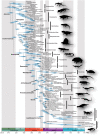

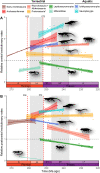
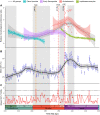
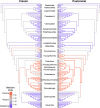
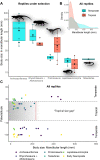
Similar articles
-
Early Triassic marine biotic recovery: the predators' perspective.PLoS One. 2014 Mar 19;9(3):e88987. doi: 10.1371/journal.pone.0088987. eCollection 2014. PLoS One. 2014. PMID: 24647136 Free PMC article.
-
Ecological dynamics of terrestrial and freshwater ecosystems across three mid-Phanerozoic mass extinctions from northwest China.Proc Biol Sci. 2021 Mar 31;288(1947):20210148. doi: 10.1098/rspb.2021.0148. Epub 2021 Mar 17. Proc Biol Sci. 2021. PMID: 33726593 Free PMC article.
-
Organism activity levels predict marine invertebrate survival during ancient global change extinctions.Glob Chang Biol. 2017 Apr;23(4):1477-1485. doi: 10.1111/gcb.13484. Epub 2016 Sep 13. Glob Chang Biol. 2017. PMID: 27570079
-
Permian-Triassic Osteichthyes (bony fishes): diversity dynamics and body size evolution.Biol Rev Camb Philos Soc. 2016 Feb;91(1):106-47. doi: 10.1111/brv.12161. Epub 2014 Nov 27. Biol Rev Camb Philos Soc. 2016. PMID: 25431138 Review.
-
The Early Origin of Feathers.Trends Ecol Evol. 2019 Sep;34(9):856-869. doi: 10.1016/j.tree.2019.04.018. Epub 2019 Jun 1. Trends Ecol Evol. 2019. PMID: 31164250 Review.
Cited by
-
Cranial anatomy of Emeroleter levis and the phylogeny of Nycteroleteridae.PLoS One. 2024 Apr 29;19(4):e0298216. doi: 10.1371/journal.pone.0298216. eCollection 2024. PLoS One. 2024. PMID: 38683802 Free PMC article.
-
A late-surviving phytosaur from the northern Atlantic rift reveals climate constraints on Triassic reptile biogeography.BMC Ecol Evol. 2023 Jul 17;23(1):33. doi: 10.1186/s12862-023-02136-8. BMC Ecol Evol. 2023. PMID: 37460985 Free PMC article.
-
Early-middle Permian Mediterranean gorgonopsian suggests an equatorial origin of therapsids.Nat Commun. 2024 Dec 17;15(1):10346. doi: 10.1038/s41467-024-54425-5. Nat Commun. 2024. PMID: 39690157 Free PMC article.
-
First evidence of Proganochelys quenstedtii (Testudinata) from the Plateosaurus bonebeds (Norian, Late Triassic) of Frick, Canton Aargau, Switzerland.Swiss J Palaeontol. 2022;141(1):17. doi: 10.1186/s13358-022-00260-4. Epub 2022 Oct 27. Swiss J Palaeontol. 2022. PMID: 36317153 Free PMC article.
-
Thalattosauria in time and space: a review of thalattosaur spatiotemporal occurrences, presumed evolutionary relationships and current ecological hypotheses.Swiss J Palaeontol. 2024;143(1):36. doi: 10.1186/s13358-024-00333-6. Epub 2024 Sep 26. Swiss J Palaeontol. 2024. PMID: 39345254 Free PMC article. Review.
References
-
- Sinervo B., Méndez-de-la-Cruz F., Miles D. B., Heulin B., Bastiaans E., Villagrán-Santa Cruz M., Lara-Resendiz R., Martínez-Méndez N., Calderón-Espinosa M. L., Meza-Lázaro R. N., Gadsden H., Avila L. J., Morando M., de la Riva I. J., Sepulveda P. V., Rocha C. F. D., Ibargüengoytía N., Puntriano C. A., Massot M., Lepetz V., Oksanen T. A., Chapple D. G., Bauer A. M., Branch W. R., Clobert J., Sites J. W. Jr., Erosion of lizard diversity by climate change and altered thermal niches. Science 328, 894–899 (2010). - PubMed
-
- Meiri S., Bauer A. M., Chirio L., Colli G. R., Das I., Doan T. M., Feldman A., Herrera F. C., Novosolov M., Pafilis P., Pincheira-Donoso D., Powney G., Torres-Carvajal O., Uetz P., van Damme R., Are lizards feeling the heat? A tale of ecology and evolution under two temperatures. Glob. Ecol. Biogeogr. 22, 834–845 (2013).
LinkOut - more resources
Full Text Sources
Miscellaneous

